back seats LINCOLN MKT 2018 Owners Manual
[x] Cancel search | Manufacturer: LINCOLN, Model Year: 2018, Model line: MKT, Model: LINCOLN MKT 2018Pages: 564, PDF Size: 4.66 MB
Page 23 of 564

•
You are required by law to properly use
safety seats for infants and toddlers in
the United States and Canada.
• Many states and provinces require that
small children use approved booster
seats until they reach age eight, a height
of 4 feet 9 inches (1.45 meters) tall, or
80 lb (36 kg). Check your local and state
or provincial laws for specific
requirements about the safety of children
in your vehicle.
• When possible, always properly restrain
children 12 years of age and under in a
rear seating position of your vehicle.
Accident statistics suggest that children
are safer when properly restrained in the
rear seating positions than in a front
seating position.
See Front Passenger
Sensing System (page 53). INSTALLING CHILD RESTRAINTS
Child Seats
Use a child safety seat (sometimes called an
infant carrier, convertible seat, or toddler
seat) for infants, toddlers or children
weighing 40 lb (18 kg) or less (generally age
four or younger). Using Lap and Shoulder Belts WARNINGS
Airbags can kill or injure a child in a
child restraint. Never place a
rear-facing child restraint in front of an active
airbag. If you must use a forward-facing child
restraint in the front seat, move the seat upon
which the child restraint is installed all the
way back. Airbags can kill or injure a child in a
child restraint. Properly restrain
children 12 and under in the rear seat
whenever possible. Depending on where you secure a
child restraint, and depending on the
child restraint design, you may block access
to certain seatbelt buckle assemblies and
LATCH lower anchors, rendering those
features potentially unusable. To avoid risk
of injury, make sure occupants only use
seating positions where they are able to be
properly restrained. 20
MKT (TP4) , enUSA, Edition date: 201703, First Printing Child SafetyE142594
Page 30 of 564
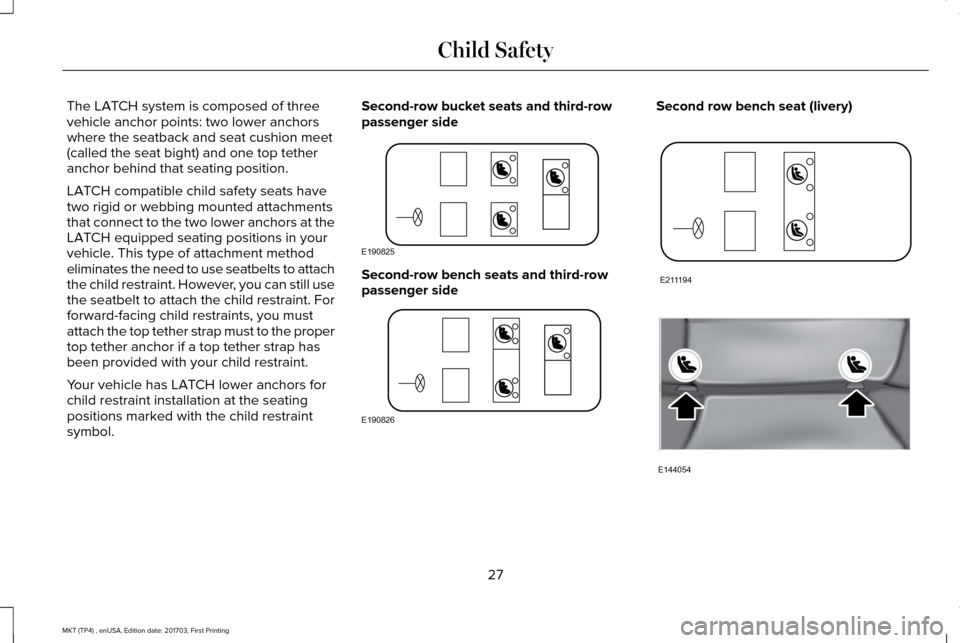
The LATCH system is composed of three
vehicle anchor points: two lower anchors
where the seatback and seat cushion meet
(called the seat bight) and one top tether
anchor behind that seating position.
LATCH compatible child safety seats have
two rigid or webbing mounted attachments
that connect to the two lower anchors at the
LATCH equipped seating positions in your
vehicle. This type of attachment method
eliminates the need to use seatbelts to attach
the child restraint. However, you can still use
the seatbelt to attach the child restraint. For
forward-facing child restraints, you must
attach the top tether strap must to the proper
top tether anchor if a top tether strap has
been provided with your child restraint.
Your vehicle has LATCH lower anchors for
child restraint installation at the seating
positions marked with the child restraint
symbol.
Second-row bucket seats and third-row
passenger side Second-row bench seats and third-row
passenger side Second row bench seat (livery)
27
MKT (TP4) , enUSA, Edition date: 201703, First Printing Child SafetyE190825 E190826 E211194 E144054
Page 31 of 564
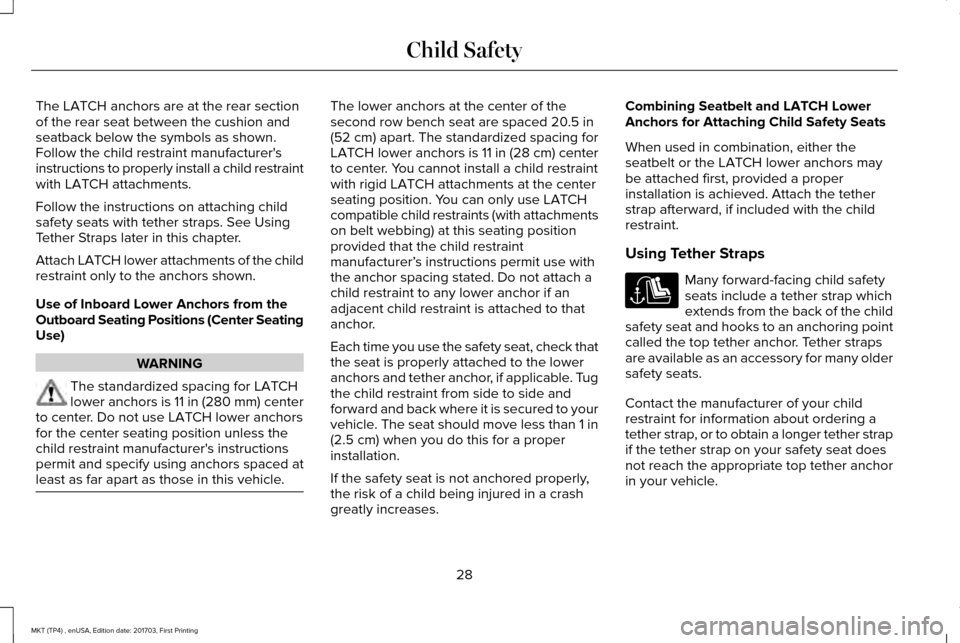
The LATCH anchors are at the rear section
of the rear seat between the cushion and
seatback below the symbols as shown.
Follow the child restraint manufacturer's
instructions to properly install a child restraint
with LATCH attachments.
Follow the instructions on attaching child
safety seats with tether straps. See Using
Tether Straps later in this chapter.
Attach LATCH lower attachments of the child
restraint only to the anchors shown.
Use of Inboard Lower Anchors from the
Outboard Seating Positions (Center Seating
Use)
WARNING
The standardized spacing for LATCH
lower anchors is 11 in (280 mm) center
to center. Do not use LATCH lower anchors
for the center seating position unless the
child restraint manufacturer's instructions
permit and specify using anchors spaced at
least as far apart as those in this vehicle. The lower anchors at the center of the
second row bench seat are spaced 20.5 in
(52 cm) apart. The standardized spacing for
LATCH lower anchors is 11 in (28 cm) center
to center. You cannot install a child restraint
with rigid LATCH attachments at the center
seating position. You can only use LATCH
compatible child restraints (with attachments
on belt webbing) at this seating position
provided that the child restraint
manufacturer’ s instructions permit use with
the anchor spacing stated. Do not attach a
child restraint to any lower anchor if an
adjacent child restraint is attached to that
anchor.
Each time you use the safety seat, check that
the seat is properly attached to the lower
anchors and tether anchor, if applicable. Tug
the child restraint from side to side and
forward and back where it is secured to your
vehicle. The seat should move less than 1 in
(2.5 cm)
when you do this for a proper
installation.
If the safety seat is not anchored properly,
the risk of a child being injured in a crash
greatly increases. Combining Seatbelt and LATCH Lower
Anchors for Attaching Child Safety Seats
When used in combination, either the
seatbelt or the LATCH lower anchors may
be attached first, provided a proper
installation is achieved. Attach the tether
strap afterward, if included with the child
restraint.
Using Tether Straps
Many forward-facing child safety
seats include a tether strap which
extends from the back of the child
safety seat and hooks to an anchoring point
called the top tether anchor. Tether straps
are available as an accessory for many older
safety seats.
Contact the manufacturer of your child
restraint for information about ordering a
tether strap, or to obtain a longer tether strap
if the tether strap on your safety seat does
not reach the appropriate top tether anchor
in your vehicle.
28
MKT (TP4) , enUSA, Edition date: 201703, First Printing Child Safety
Page 35 of 564
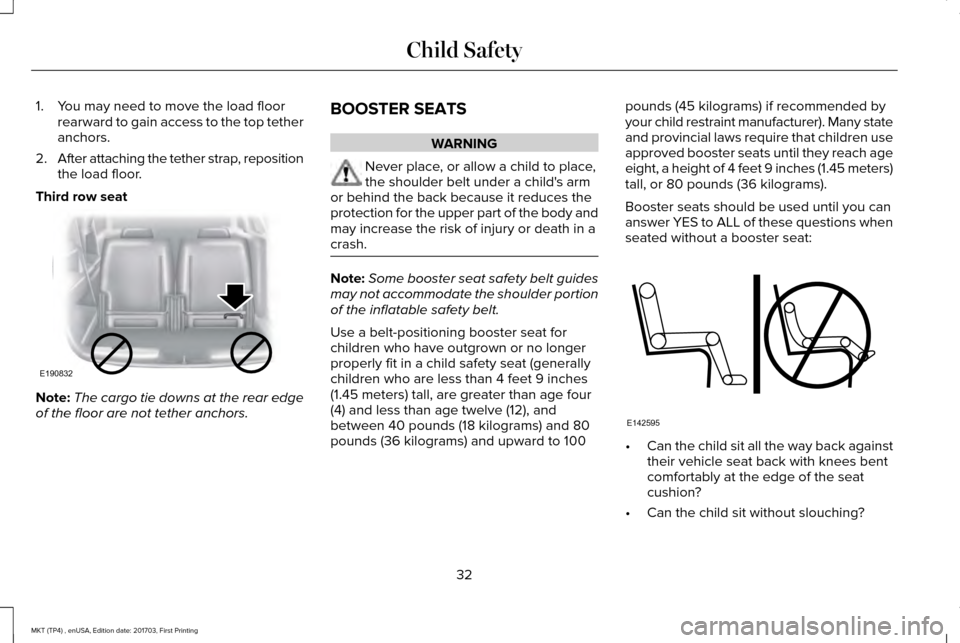
1. You may need to move the load floor
rearward to gain access to the top tether
anchors.
2. After attaching the tether strap, reposition
the load floor.
Third row seat Note:
The cargo tie downs at the rear edge
of the floor are not tether anchors. BOOSTER SEATS WARNING
Never place, or allow a child to place,
the shoulder belt under a child's arm
or behind the back because it reduces the
protection for the upper part of the body and
may increase the risk of injury or death in a
crash. Note:
Some booster seat safety belt guides
may not accommodate the shoulder portion
of the inflatable safety belt.
Use a belt-positioning booster seat for
children who have outgrown or no longer
properly fit in a child safety seat (generally
children who are less than 4 feet 9 inches
(1.45 meters) tall, are greater than age four
(4) and less than age twelve (12), and
between 40 pounds (18 kilograms) and 80
pounds (36 kilograms) and upward to 100 pounds (45 kilograms) if recommended by
your child restraint manufacturer). Many state
and provincial laws require that children use
approved booster seats until they reach age
eight, a height of 4 feet 9 inches (1.45 meters)
tall, or 80 pounds (36 kilograms).
Booster seats should be used until you can
answer YES to ALL of these questions when
seated without a booster seat:
•
Can the child sit all the way back against
their vehicle seat back with knees bent
comfortably at the edge of the seat
cushion?
• Can the child sit without slouching?
32
MKT (TP4) , enUSA, Edition date: 201703, First Printing Child SafetyE190832 E142595
Page 36 of 564
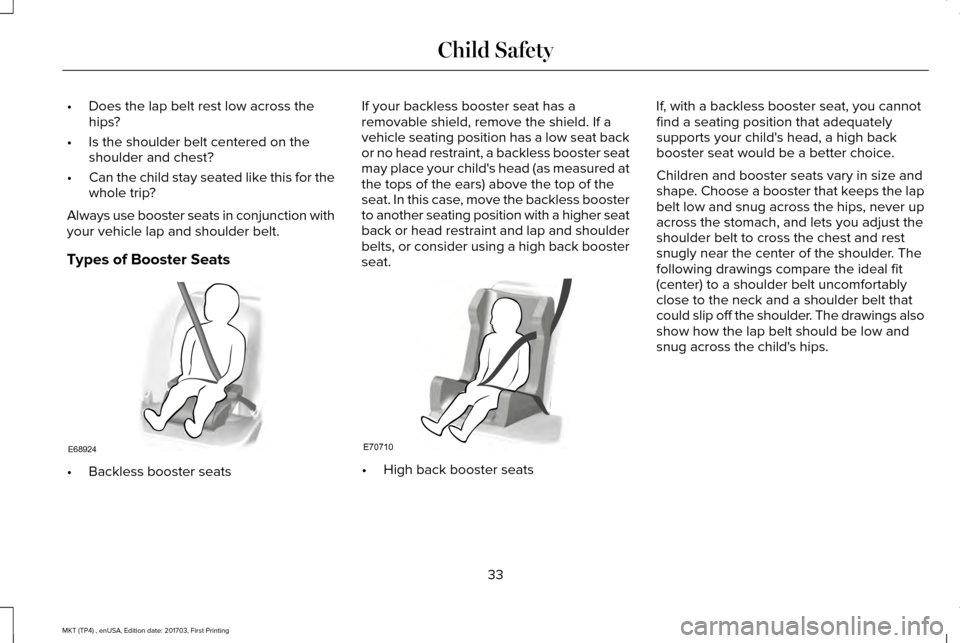
•
Does the lap belt rest low across the
hips?
• Is the shoulder belt centered on the
shoulder and chest?
• Can the child stay seated like this for the
whole trip?
Always use booster seats in conjunction with
your vehicle lap and shoulder belt.
Types of Booster Seats •
Backless booster seats If your backless booster seat has a
removable shield, remove the shield. If a
vehicle seating position has a low seat back
or no head restraint, a backless booster seat
may place your child's head (as measured at
the tops of the ears) above the top of the
seat. In this case, move the backless booster
to another seating position with a higher seat
back or head restraint and lap and shoulder
belts, or consider using a high back booster
seat.
•
High back booster seats If, with a backless booster seat, you cannot
find a seating position that adequately
supports your child's head, a high back
booster seat would be a better choice.
Children and booster seats vary in size and
shape. Choose a booster that keeps the lap
belt low and snug across the hips, never up
across the stomach, and lets you adjust the
shoulder belt to cross the chest and rest
snugly near the center of the shoulder. The
following drawings compare the ideal fit
(center) to a shoulder belt uncomfortably
close to the neck and a shoulder belt that
could slip off the shoulder. The drawings also
show how the lap belt should be low and
snug across the child's hips.
33
MKT (TP4) , enUSA, Edition date: 201703, First Printing Child SafetyE68924 E70710
Page 41 of 564
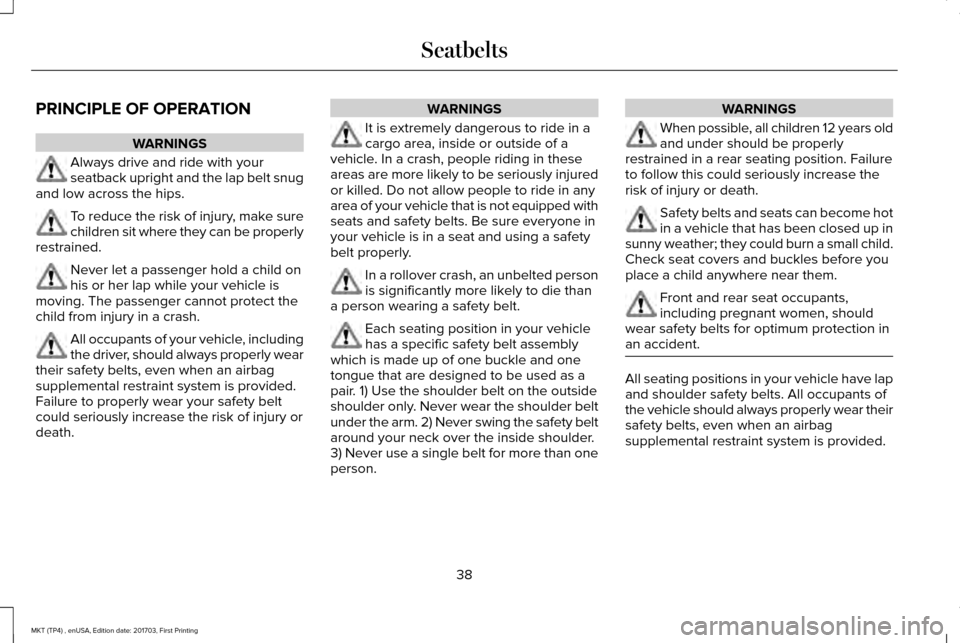
PRINCIPLE OF OPERATION
WARNINGS
Always drive and ride with your
seatback upright and the lap belt snug
and low across the hips. To reduce the risk of injury, make sure
children sit where they can be properly
restrained. Never let a passenger hold a child on
his or her lap while your vehicle is
moving. The passenger cannot protect the
child from injury in a crash. All occupants of your vehicle, including
the driver, should always properly wear
their safety belts, even when an airbag
supplemental restraint system is provided.
Failure to properly wear your safety belt
could seriously increase the risk of injury or
death. WARNINGS
It is extremely dangerous to ride in a
cargo area, inside or outside of a
vehicle. In a crash, people riding in these
areas are more likely to be seriously injured
or killed. Do not allow people to ride in any
area of your vehicle that is not equipped with
seats and safety belts. Be sure everyone in
your vehicle is in a seat and using a safety
belt properly. In a rollover crash, an unbelted person
is significantly more likely to die than
a person wearing a safety belt. Each seating position in your vehicle
has a specific safety belt assembly
which is made up of one buckle and one
tongue that are designed to be used as a
pair. 1) Use the shoulder belt on the outside
shoulder only. Never wear the shoulder belt
under the arm. 2) Never swing the safety belt
around your neck over the inside shoulder.
3) Never use a single belt for more than one
person. WARNINGS
When possible, all children 12 years old
and under should be properly
restrained in a rear seating position. Failure
to follow this could seriously increase the
risk of injury or death. Safety belts and seats can become hot
in a vehicle that has been closed up in
sunny weather; they could burn a small child.
Check seat covers and buckles before you
place a child anywhere near them. Front and rear seat occupants,
including pregnant women, should
wear safety belts for optimum protection in
an accident. All seating positions in your vehicle have lap
and shoulder safety belts. All occupants of
the vehicle should always properly wear their
safety belts, even when an airbag
supplemental restraint system is provided.
38
MKT (TP4) , enUSA, Edition date: 201703, First Printing Seatbelts
Page 55 of 564
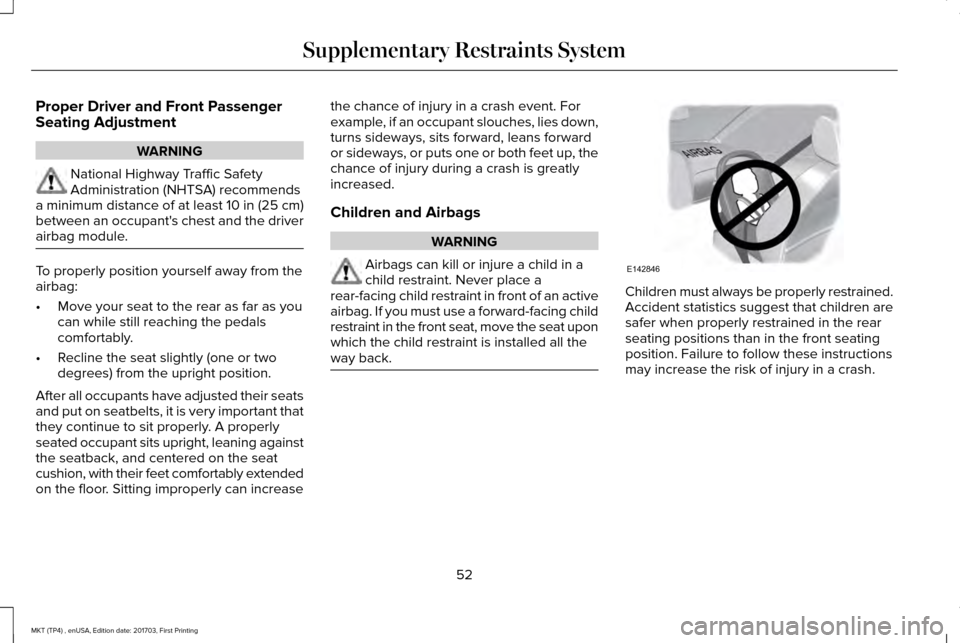
Proper Driver and Front Passenger
Seating Adjustment
WARNING
National Highway Traffic Safety
Administration (NHTSA) recommends
a minimum distance of at least 10 in (25 cm)
between an occupant's chest and the driver
airbag module. To properly position yourself away from the
airbag:
•
Move your seat to the rear as far as you
can while still reaching the pedals
comfortably.
• Recline the seat slightly (one or two
degrees) from the upright position.
After all occupants have adjusted their seats
and put on seatbelts, it is very important that
they continue to sit properly. A properly
seated occupant sits upright, leaning against
the seatback, and centered on the seat
cushion, with their feet comfortably extended
on the floor. Sitting improperly can increase the chance of injury in a crash event. For
example, if an occupant slouches, lies down,
turns sideways, sits forward, leans forward
or sideways, or puts one or both feet up, the
chance of injury during a crash is greatly
increased.
Children and Airbags
WARNING
Airbags can kill or injure a child in a
child restraint. Never place a
rear-facing child restraint in front of an active
airbag. If you must use a forward-facing child
restraint in the front seat, move the seat upon
which the child restraint is installed all the
way back. Children must always be properly restrained.
Accident statistics suggest that children are
safer when properly restrained in the rear
seating positions than in the front seating
position. Failure to follow these instructions
may increase the risk of injury in a crash.
52
MKT (TP4) , enUSA, Edition date: 201703, First Printing Supplementary Restraints SystemE142846
Page 58 of 564
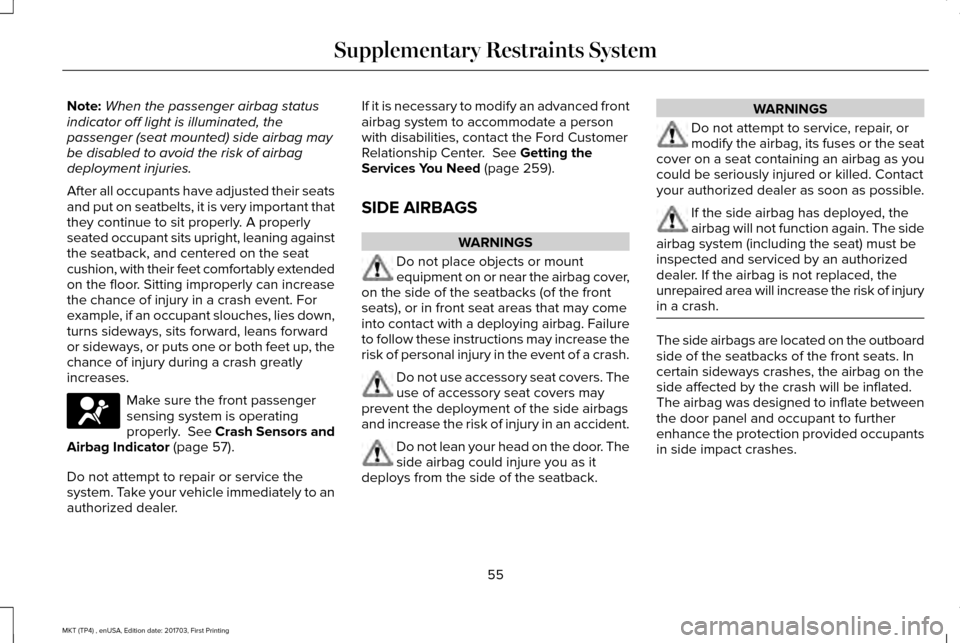
Note:
When the passenger airbag status
indicator off light is illuminated, the
passenger (seat mounted) side airbag may
be disabled to avoid the risk of airbag
deployment injuries.
After all occupants have adjusted their seats
and put on seatbelts, it is very important that
they continue to sit properly. A properly
seated occupant sits upright, leaning against
the seatback, and centered on the seat
cushion, with their feet comfortably extended
on the floor. Sitting improperly can increase
the chance of injury in a crash event. For
example, if an occupant slouches, lies down,
turns sideways, sits forward, leans forward
or sideways, or puts one or both feet up, the
chance of injury during a crash greatly
increases. Make sure the front passenger
sensing system is operating
properly. See Crash Sensors and
Airbag Indicator (page 57).
Do not attempt to repair or service the
system. Take your vehicle immediately to an
authorized dealer. If it is necessary to modify an advanced front
airbag system to accommodate a person
with disabilities, contact the Ford Customer
Relationship Center.
See Getting the
Services You Need (page 259).
SIDE AIRBAGS WARNINGS
Do not place objects or mount
equipment on or near the airbag cover,
on the side of the seatbacks (of the front
seats), or in front seat areas that may come
into contact with a deploying airbag. Failure
to follow these instructions may increase the
risk of personal injury in the event of a crash. Do not use accessory seat covers. The
use of accessory seat covers may
prevent the deployment of the side airbags
and increase the risk of injury in an accident. Do not lean your head on the door. The
side airbag could injure you as it
deploys from the side of the seatback. WARNINGS
Do not attempt to service, repair, or
modify the airbag, its fuses or the seat
cover on a seat containing an airbag as you
could be seriously injured or killed. Contact
your authorized dealer as soon as possible. If the side airbag has deployed, the
airbag will not function again. The side
airbag system (including the seat) must be
inspected and serviced by an authorized
dealer. If the airbag is not replaced, the
unrepaired area will increase the risk of injury
in a crash. The side airbags are located on the outboard
side of the seatbacks of the front seats. In
certain sideways crashes, the airbag on the
side affected by the crash will be inflated.
The airbag was designed to inflate between
the door panel and occupant to further
enhance the protection provided occupants
in side impact crashes.
55
MKT (TP4) , enUSA, Edition date: 201703, First Printing Supplementary Restraints SystemE67017
Page 138 of 564
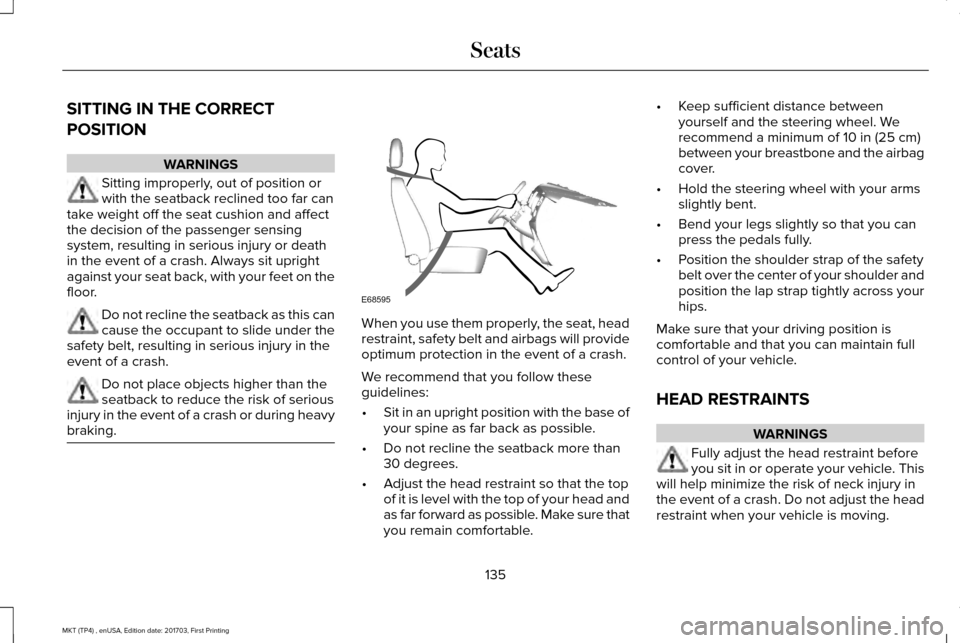
SITTING IN THE CORRECT
POSITION
WARNINGS
Sitting improperly, out of position or
with the seatback reclined too far can
take weight off the seat cushion and affect
the decision of the passenger sensing
system, resulting in serious injury or death
in the event of a crash. Always sit upright
against your seat back, with your feet on the
floor. Do not recline the seatback as this can
cause the occupant to slide under the
safety belt, resulting in serious injury in the
event of a crash. Do not place objects higher than the
seatback to reduce the risk of serious
injury in the event of a crash or during heavy
braking. When you use them properly, the seat, head
restraint, safety belt and airbags will provide
optimum protection in the event of a crash.
We recommend that you follow these
guidelines:
•
Sit in an upright position with the base of
your spine as far back as possible.
• Do not recline the seatback more than
30 degrees.
• Adjust the head restraint so that the top
of it is level with the top of your head and
as far forward as possible. Make sure that
you remain comfortable. •
Keep sufficient distance between
yourself and the steering wheel. We
recommend a minimum of 10 in (25 cm)
between your breastbone and the airbag
cover.
• Hold the steering wheel with your arms
slightly bent.
• Bend your legs slightly so that you can
press the pedals fully.
• Position the shoulder strap of the safety
belt over the center of your shoulder and
position the lap strap tightly across your
hips.
Make sure that your driving position is
comfortable and that you can maintain full
control of your vehicle.
HEAD RESTRAINTS WARNINGS
Fully adjust the head restraint before
you sit in or operate your vehicle. This
will help minimize the risk of neck injury in
the event of a crash. Do not adjust the head
restraint when your vehicle is moving.
135
MKT (TP4) , enUSA, Edition date: 201703, First Printing SeatsE68595
Page 139 of 564
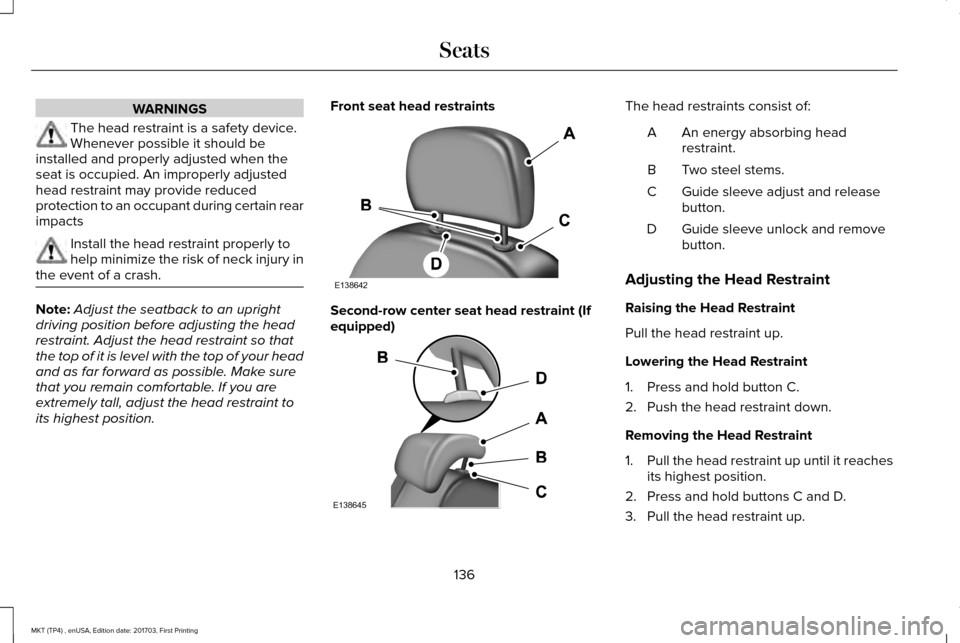
WARNINGS
The head restraint is a safety device.
Whenever possible it should be
installed and properly adjusted when the
seat is occupied. An improperly adjusted
head restraint may provide reduced
protection to an occupant during certain rear
impacts Install the head restraint properly to
help minimize the risk of neck injury in
the event of a crash. Note:
Adjust the seatback to an upright
driving position before adjusting the head
restraint. Adjust the head restraint so that
the top of it is level with the top of your head
and as far forward as possible. Make sure
that you remain comfortable. If you are
extremely tall, adjust the head restraint to
its highest position. Front seat head restraints
Second-row center seat head restraint (If
equipped) The head restraints consist of:
An energy absorbing head
restraint.
A
Two steel stems.
B
Guide sleeve adjust and release
button.
C
Guide sleeve unlock and remove
button.
D
Adjusting the Head Restraint
Raising the Head Restraint
Pull the head restraint up.
Lowering the Head Restraint
1. Press and hold button C.
2. Push the head restraint down.
Removing the Head Restraint
1. Pull the head restraint up until it reaches
its highest position.
2. Press and hold buttons C and D.
3. Pull the head restraint up.
136
MKT (TP4) , enUSA, Edition date: 201703, First Printing SeatsE138642 E138645